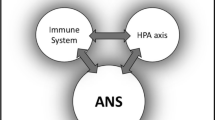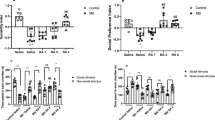Abstract
After stress (immobilization in cages) plasma corticosterone level in prematurely aging OXYS rats was higher, while the content of NO metabolites was much lower than in Wistar rats. Stress increased blood pressure in OXYS and Wistar rats, the maximum values were observed in control and stressed OXYS rats. The concentration of reduced glutathione in the brain of OXYS rats was lower than in Wistar rats. After immobilization the concentration of reduced glutathione decreased in animals of both strains. The concentration of oxidized protein increased by 1.5 times only in OXYS rats. SOD activity remained unchanged, but in OXYS rats this parameter was higher than in Wistar rats. It can be hypothesized that high blood pressure, low NO content, high corticosterone concentration, and stress-induced deficiency of the antioxidant system (or combined effects of these factors) contribute to the development of neurodegenerative changes in the brain of OXYS rats.
Similar content being viewed by others
REFERENCES
N. G. Kolosova, S. V. Aidagulova, G. I. Nepomnyashchikh, et al., Byull. Eksp. Biol. Med., 132, No.8, 235–240 (2001).
L. V. Loskutova and L. M. Zelenkina, Zh. Vyssh. Nervn. Deyat., 52, No.3, 366–371 (2002).
L. V. Loskutova and N. G. Kolosova, Byull. Eksp. Biol. Med., 130, No.8, 155–158 (2000).
E. B. Menshikova, I. G. Shabalina, N. K. Zenkov, and N. G. Kolosova, Ibid., 133, No.2, 207–210 (2002).
T. S. Kostic, S. A. Andric, D. Maric, and R. Z. Kovacevic, J. Steroid Biochem. Mol. Biol., 75, Nos.4–5, 299–306 (2000).
J. A. Navarro-Gonzales, S. Garcia-Benayas, and J. A. Arenas, Clin. Chem., 44, No.3, 679–681 (1998).
N. V. Patel and C. E. Finch, Neurobiol. Aging, 23, No.5, 707–717 (2002).
A. Z. Reznick and L. Packer, Methods Enzymol., 233, 357–363 (1994).
R. I. Salganik, N. A. Solovyova, S. I. Dikalov, et al., Biochem. Biophys. Res. Commun., 199, No.2, 726–732 (1994).
N. K. Zenkov, E. B. Menshikova, and N. G. Kolosova, Usp. Gerontol., No. 6, 73 (2001).
Author information
Authors and Affiliations
Corresponding author
Additional information
__________
Translated from Byulleten’ Eksperimental’noi Biologii i Meditsiny, Vol. 139, No. 4, pp. 387–390, April, 2005
Rights and permissions
About this article
Cite this article
Kolosova, N.G., Trofimova, N.A., Shcheglova, T.V. et al. Increased Stress Reactivity as a Possible Factor of Early Degenerative Changes in OXYS Rats. Bull Exp Biol Med 139, 397–399 (2005). https://doi.org/10.1007/s10517-005-0304-4
Received:
Issue Date:
DOI: https://doi.org/10.1007/s10517-005-0304-4




